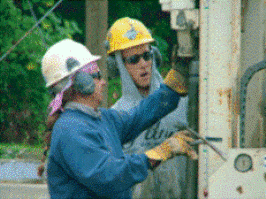|
Recently there have been two fatal accidents that crossed my
desk. The first occurred when a worker was
using a skid steer to push a flatbed truck
which had unsecured pipes on its bed. One
of the rods flew off the back of the truck
and impaled the worker. The other incident,
which certainly hit closer to home, involved
a younger worker (25 years old) who was
kicking a rotating auger in an effort to
remove dirt. His loose shoe lace got caught
by the rotation and he died from the head
injuries he suffered from the fall. When
these tragic accidents were discussed with
my colleagues, the overwhelming thought was
‘where was the common sense?”
Webster’s Dictionary defines common sense this way; “Sound
and prudent judgment based on a simple
perception of the situation or facts.” I
have been a H&S instructor for 22 years and
have had over 10,000 people in my classes.
Without hesitation I can state that you just
can’t teach commons sense. You can however,
demonstrate its use, mentor the younger less
experienced workers, reward positive actions
and learn from damaging actions and
incidents. The winter months are notorious
for accidents. Wet leaves, ice, shorter
hours of light, ailments associated with the
cold damp weather, mud and many other
factors all make construction activities of
any kind more precarious. Here are some
tips for keeping safe and healthy.
Practice common
sense.
If it looks unsafe, it probably is. Let the
younger workers learn from the experience of
the seasoned professionals.
|
|

Slow down.
Not only on the road, but in all your
tasks. Working faster seldom has positive
outcomes. Take your time and do the job
right.
Clean up your work area.
Slip and trip hazards are responsible for a
large number of injuries each year.
Eliminating the mess not only decreases the
potential for an accident, it says a lot
about the quality of your work.
Don’t remain silent.
If you see someone or something that is
unsafe make it known. Too often do we
become complacent and think that “someone
else will worry about that.” If you see a
problem, initiate the resolution.
Ask for help.
You can act tough on your own time. If you
really could use a hand with an activity,
especially lifting, than get the help.
Sitting at home with a back injury is no fun
and it won’t pay your bills.
It is an unfortunate fact that our industry
has many dangerous activities. But working
smart and using your head before your body
can decrease the possibility of getting hurt
by 90%. The odds are in your favor, it’s up
to you to make it work. |

